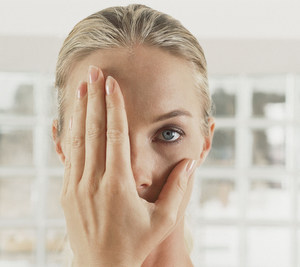
It’s often said that your eyes are the first thing that people notice about you—and, unfortunately, they’re also the part of your body that can age you beyond your years. If you have dark circles or droopy “bags” under your eyes, you may look sick, tired, and much older than your chronological age.
The good news is that, often, your eye woes are not caused by sickness, exhaustion, or even age, but rather by health issues that are completely treatable.
To help you navigate the possible causes and decide what safe, noninvasive treatments to try, here are a few of the most common factors that can give the appearance of under eye circles.
Cause #1: Nasal Issues
The skin under your eyes is about one-fourth the thickness of the skin elsewhere on your body, so it’s quite delicate and translucent, easily revealing the bluish cast of underlying veins. One of the most common causes of dark circles and puffiness under the eyes is enlargement of those veins—and one of the most common causes of the enlargement is nasal congestion from a cold, a crying bout, sinus problems, house mold, or allergies.
The veins in your eye area drain through the veins in your nose, and stuffiness in your nasal passages impedes venous drainage, resulting in a backup.
If issues with nasal drainage are causing the dark circles under your eyes, there are some things you can do at home to clear your sinuses.
First, try using a neti pot. Flushing your nasal passages with a neti pot can reduce inflammation and congestion in your passages. It can also remove millions of viruses and bacteria, making it easier for your immune system to fight whatever bug is causing the congestion. Flush your nasal passages every six to eight hours.
Second, try taking an herbal sinus remedy, such as Sinupret forte, that promotes a normal inflammatory response and mucus production. Also, reduce allergy-causing microbes in your house by using an air purifier.
Cause #2: Fragile Capillaries
Capillaries (micro-thin blood vessels) deliver blood as close as possible to your tissues, then allow the nutrient-rich fluid (plasma) of blood to seep into the tissues through fenestrations—windows in the capillary walls. This is called capillary permeability.
If your capillaries are too permeable (meaning the windows open too wide), red blood cells (RBCs) slip through along with the plasma. To clean up the spill, enzymes break down the RBCs, staining the tissues with hemoglobin, which turns dark when it’s metabolized. It’s like getting a bruise without the trauma.
If this happens under your eyes, you’ll have dark circles, possibly accompanied by some under-eye puffiness because cleaning up spilled debris is an inflammatory process. The same thing happens if your capillaries are overly fragile.
A common cause of excessively permeable and/or fragile capillaries is a change in nutritional status, which often happens with age. You can reverse this phenomenon if you make sure to include the following basic nutrients, which have been proven to restore capillary integrity, in your nutritional regimen:
- Zinc. Blood zinc levels in elderly patients with senile purpura (purple spots on the skin from capillary leakage) are significantly lower than in age-matched people without purpura. Make sure you get 15–20 mg of zinc per day.
- Mineral-buffered vitamin C is proven to prevent free-radical damage to capillary walls and encourage already-damaged vessels to heal (November 2004, European Journal of Internal Medicine). Take 1–3 grams daily in divided doses, taken with the next two bioflavonoids.
- Hesperidin, which is prominent in citrus fruits. Fragile capillaries improve with vitamin C or hesperidin, but when the two are combined, capillary strength is almost 100 percent restored (1955, American Practitioner and Digest of Treatment). Read product labels for dosage information.
- Rutin, a bioflavonoid from buckwheat and other sources. Rutin strengthens and maintains capillary integrity and regulates capillary permeability. Take 400 mg twice daily.
Cause #3: Hormone Imbalance
Estrogen dominance can exacerbate bruising. This can contribute to hemoglobin-related under-eye circles.
Switching to a vegetarian-emphasis diet can help keep your estrogen levels in better balance. Avoid red meat in favor of free-range turkey and wild, cold-water fish (salmon, tuna, or mackerel) once or twice per week. Eat plenty of dark-green leafy vegetables, root vegetables, and whole grains to boost your phytoestrogens, which are excellent for occupying estrogen-binding sites so that excess estrogen can be eliminated more easily.
Cause #4: Sun Damage
A 1989 study at Yale School of Medicine showed that menopausal women experienced increased bruising on sun-exposed skin, suggesting that sun damage accelerated age- and hormone-related changes in the skin at the cellular level.
How do you balance your need for vitamin D—the “sunshine vitamin”—without harming your face and delicate eye area?
For short bouts in the sun, use sunscreen on only your thinnest, most commonly exposed and sun-damaged skin—your face, hands, décolletage, and forearms—and let the sun rain down for about 15 minutes a day on the thicker skin of your thighs, where subcutaneous fat provides the components necessary for vitamin D synthesis. Remember, though, that if you’re planning on being in the sun for longer than 15 minutes, apply sunscreen all over. And be sure to avoid the sun’s strongest rays between 10 AM and 2 PM.
Now that you know some of the underlying causes of under-eye circles and bags, I hope you’ll try these noninvasive treatments before resorting to drastic cosmetic procedures or surgeries. I think you’ll notice significant improvement once you start implementing these solutions!
Now it’s your turn: Do you struggle with under eye circles?


